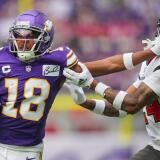How to draft WRs in 2025 Fantasy Football: Strategies and targets for all leagues include upside plays to know
Everything you need to know about drafting a wide receiver in 2025 -- your draft prep starts here!

Take a gander at the top receivers in our Fantasy rankings. At what point do you feel like there's a drop-off from the elite-tier talent to the next tier? Or think of it this way: Where does the list of guys who could land 18-plus PPR points (eight catches, 100 yards) on a per-game basis end and the list of everyone else begin?
The lower that number is for you, the more you should prioritize wide receivers in the early rounds of your Fantasy drafts in full- and half-PPR leagues.
It's simple to do: Take a rankings list (like one of these!), highlight the big-time studs who can average a high number. Those are your targets in Rounds 1 and 2, provided there isn't a running back you like more.
But you're not done. You should then highlight the pass-catchers who you think can average at least 15 PPR points. Those are the next ones. You might find that there aren't a lot of those guys either.
The lower that number is for you, the more you should prioritize wide receivers in the first four rounds of your draft. This is a biggie -- the genesis of your draft prep and your draft philosophy, in my opinion -- because once that group of receivers is gone, you're not really gonna love what comes next.
What to look for in a wide receiver
When considering a wide receiver, you should target:
- A WR who consistently gets at least seven targets per game (eight would be outstanding)
- A WR who can separate not just with speed, but with agility and physicality
- A WR connected to a great quarterback
- A WR connected to a high-scoring offense
- A WR who isn't on a team that gets really run-heavy in the red zone
- A WR who you believe can give you 15-plus PPR/12-plus half-PPR/10-plus non-PPR points per game
That last point is the real key because it feels like this year's group of wide receivers is lean on high-production talent. That's because there is a tier (more like a blob) of wide receivers who could hit the 15 PPR point mark, but could also fall as far as 11 PPR points per game. It's a gaggle of wideouts with just as much breakout potential as bust potential.
And if you just don't want to deal with them, then your WR strategy is pretty much laid out for you.
Load up on WRs early?
The fewer receivers you covet, the more likely you'll take two with your first three picks, if not your first two. You must be committed to receivers if you do this and therefore okay with starting the types of running backs you'll see in Rounds 3 through 5 -- not that those guys are bad players! In fact, you might love the running backs in that range compared to the receivers. If so, start strong with wideouts. It's a great idea in full-PPR leagues and a good idea in half-PPR leagues. Getting two elite-tier receivers should give your team an advantage.
What about getting just one WR early?
It's kind of like the Hero RB strategy but with WRs: Take one, hope he proves to be an anchor for your team, build at other positions, and fill in other receivers later on in the draft and into the season. Fantasy drafters should be fine with this strategy as long as they like a lot of receivers (at least 25 of them) to be quality starters or if they land some great values at other positions in the draft. As in, you can't pass up Josh Allen in Round 4, so you take him over what would have been your second receiver. The less receptions count, the more I like this plan of attack.
Is there such a thing as Zero WR?
It's rare, but occasionally you'll see Fantasy managers avoid receivers entirely for the first four rounds. The thought process behind this is to rack up stars at other positions and figure you'll land some pass-catchers who deliver past expectations in the draft and off waivers. There's probably an emphasis on targeting rookie receivers in this strategy -- think of how last year's class exploded on the scene, then think about this year's tantalizing crop. I wouldn't recommend this concept, but it could be reasonably effective in smaller leagues and non-PPR formats.
Is balanced drafting is the way?
It's what you'll see from most people this year -- two wide receivers within the first four picks, maybe three or four within the first seven, depending on starting lineup requirements. A lot of folks will just take RBs and WRs for the first few rounds, so they're getting the best talent they can in the early going. It feels safest, and since most folks are risk-averse, this will be popular. And it's not wrong to do! It'll work in any format.
How to prioritize WRs in Round 7 and beyond?
The more receivers you start in your lineup, the more depth you'll want on your team. In a two-receiver league, I'll take at least four receivers with the idea that one can start in my flex and another sits on the bench. If it's a three-receiver league, then that number rises to six receivers total since more of them will be in my lineup. You may opt for more receivers on your bench, which is great, but because receivers tend to be easier to find off of waivers, I don't want to overload bench spots with WRs when I can take shots on high-upside RBs instead.
Look for upside from those mid-to-late round receivers. Can a receiver finish second on his team in targets? How about first?! Does he have a good skill set? Is it a young player who's gotten good buzz from training camp observers? You'll probably lean into the rookie class (Tetairoa McMillan and Travis Hunter will be long gone by this point, but Matthew Golden and Emeka Egbuka won't be) and also pick up some yet-to-be-proven second-year receivers too (Ricky Pearsall, Rome Odunze, Keon Coleman).
You will see some veteran receivers who are deemed "high-floor" or "safe." Those are kind ways of saying "lacking upside." Not that they'll be bad for your Fantasy squad, but they're more like bench guys you'll use during bye weeks or when injuries hit, and you wouldn't expect a lot of touchdowns or a bunch of 100-yard games. You wouldn't normally start them in typically sized formats, so why invest in them unless they were taken at a late value?
More questions, more answers
How should drafters view receivers who are hurt, expected to be suspended, or holding out from practice? Simple: Don't take them unless it's at a great value. Every year, receivers become unpopular due to August injuries or financial scuffles. I wouldn't expect anyone who falls under those labels to make immediate impacts, but it's a long football season, and sometimes players can regain their form just in time for when it matters: the Fantasy playoff push. Rashee Rice, Terry McLaurin, Jordan Addison, Chris Godwin, and Jauan Jennings all qualify as WRs to draft after their current average draft positions. If you can, just not before, unless significant news changes their outlook.
What changes in a half-PPR league? Any receiver who is known for catching a lot of passes but not doing a ton with them (low receiving average, low touchdown numbers) will get devalued more than the rest of the receivers in the class. That's simple math; running backs will get pushed up a little bit. All of the strategies are still in play.
What changes in a non-PPR league? Receivers will lose their edge over running backs because receptions don't matter. All that's left are yards and touchdowns, and running backs tend to get those in larger quantities than typical receivers. Any receiver who's known for getting 100-plus receptions without a big receiving average or a high touchdown expectation would especially lose value, perhaps by as much as a full round. This would be the format to get running backs early.
What if it's a league of 10 or fewer teams? I'd be more inclined to chase running backs over receivers, or at least be balanced between them. Top-tier tight ends and quarterbacks would also be of interest, though in the case of quarterbacks, the depth might make them easier to wait for.
What if it's a league of 14 or more teams? I'd prioritize the top receivers to the point where I'd take two with my first three picks, as long as receptions counted. If receptions didn't count for much, then it'll probably be two running backs I'd aim for with one receiver. There's a key point here: I don't want my No. 2 WR spot to be a weak spot in this deep of a format, especially if I have to start three receivers. Every team in a 14-person league will have at least one weakness; if mine is at my No. 3 receiver spot, I'd be okay with it. But not the No. 2.
What if I have more questions? You can always reach out on X (@daverichard) or drop the Fantasy Football Today Podcast a line (fantasyfootball@cbsi.com). Our rankings are updated daily and can always be found here.

















